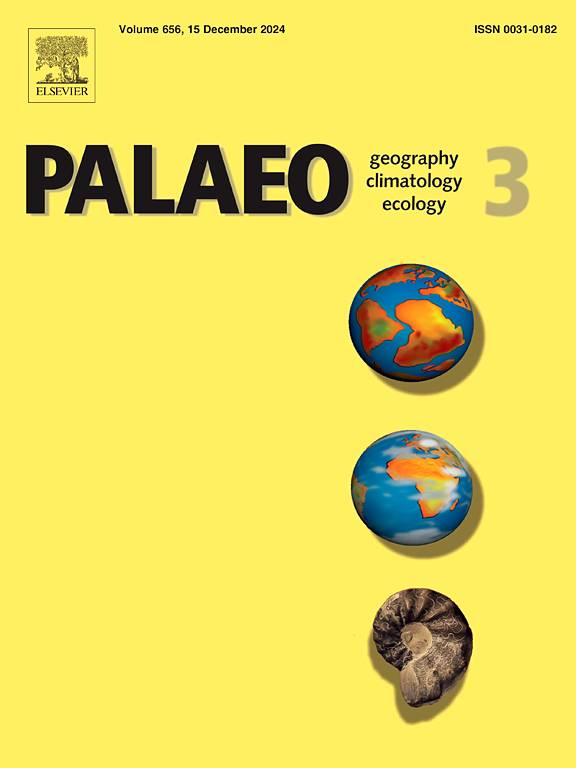华南深冷系大塘坡组古海洋化学特征及其对锰成矿的意义
IF 2.7
2区 地球科学
Q2 GEOGRAPHY, PHYSICAL
Palaeogeography, Palaeoclimatology, Palaeoecology
Pub Date : 2025-08-20
DOI:10.1016/j.palaeo.2025.113212
引用次数: 0
摘要
古海洋化学变化对认识华南深冷系大塘坡组锰矿床成因具有重要意义。根据重庆ZK0602岩心的岩石学观察和铁形态、钼(Mo)、铀(U)、钒(V)、锰(Mn)浓度、Sr/Ba比值、蚀变化学指数(CIA)和黄铁矿硫同位素(δ34Spy)等地球化学指标,将大塘坡组下黑色页岩划分为4个层段(ⅰ、ⅱ、ⅲ、ⅳ层段)。值得注意的是,相对较高的Mn浓度和成矿作用与层段II的含铁海洋条件有关,该层段夹在两个含氧的新鲜微咸层段(I和III)之间。提出了一个新的概念框架来解释氧化还原条件、盐度波动和锰成矿之间的共同演化动力学。在第1段和第3段,Sturtian脱冰驱动的变暖增强了化学风化作用,增加了陆源对盆地的输入,降低了水柱盐度。同时,来自远洋和陆源的营养物质的增加增加了地表水的初级生产力和随后在水柱中的厌氧有机质矿化,诱发了底水硫化物和促进黄铁矿的形成。间冰期II期,随着间冰期冰川的出现,化学风化作用减弱,陆源输入减少,盆地水体盐度上升至海洋水平。来自海洋和陆地的养分供应减少,初级生产力下降,有机质和硫酸盐的向下通量减少。这种转变有利于锰还原作为主要的有机物质氧化途径。在含铁条件下,Mn矿在水-沉积物界面附近沉淀。本文章由计算机程序翻译,如有差异,请以英文原文为准。
Paleo-ocean chemistry characteristics of the Cryogenian Datangpo Formation in South China and implications for manganese metallogenesis
Paleo-ocean chemical variations play a critical role in understanding the genesis of manganese (Mn) ore deposits within the Cryogenian Datangpo Formation of South China. Based on lithological observations and multiple geochemical proxies—including iron speciation, molybdenum (Mo), uranium (U), vanadium (V), manganese (Mn) concentrations, Sr/Ba ratios, the Chemical Index of Alteration (CIA), and pyrite sulfur isotopes (δ34Spy)—from drill core ZK0602 in Chongqing, South China, the lower black shales of the Datangpo Formation were deposited under euxinic fresh-brackish water conditions and can be subdivided into four intervals (Intervals I, II, III, and IV). Notably, relatively high Mn concentrations and metallogenesis are genetically linked to ferruginous marine conditions in interval II, which is sandwiched between two euxinic fresh-brackish intervals (I and III). An updated conceptual framework is proposed to decipher the co-evolutionary dynamics among redox condition, salinity fluctuations, and manganese metallogenesis. During intervals I and III, Sturtian deglaciation-driven warming enhanced chemical weathering, increasing terrigenous input to the basin and reducing water-column salinity. Concurrently, elevated nutrient inputs from both open-ocean and terrigenous sources heightened surface-water primary productivity and subsequent anaerobic organic matter mineralization in the water column, inducing bottom-water sulfidization and promoting pyrite formation. In contrast, during interval II, as glacial stadials emerged within the interglacial period, chemical weathering weakened, terrigenous input decreased, and the salinity of the basin water body rose to marine levels. Diminished nutrient supplies from both oceanic and terrestrial sources decreased primary productivity, reducing the downward flux of organic matter and sulfate. This shift favored manganese reduction as the dominant organic matter oxidation pathway. Under ferruginous conditions, Mn ore precipitated near the water–sediment interface.
求助全文
通过发布文献求助,成功后即可免费获取论文全文。
去求助
来源期刊
CiteScore
5.90
自引率
10.00%
发文量
398
审稿时长
3.8 months
期刊介绍:
Palaeogeography, Palaeoclimatology, Palaeoecology is an international medium for the publication of high quality and multidisciplinary, original studies and comprehensive reviews in the field of palaeo-environmental geology. The journal aims at bringing together data with global implications from research in the many different disciplines involved in palaeo-environmental investigations.
By cutting across the boundaries of established sciences, it provides an interdisciplinary forum where issues of general interest can be discussed.

 求助内容:
求助内容: 应助结果提醒方式:
应助结果提醒方式:


